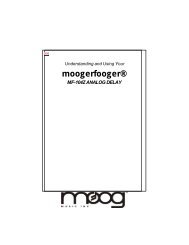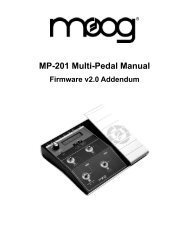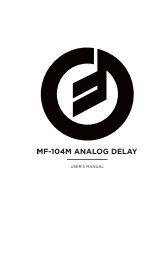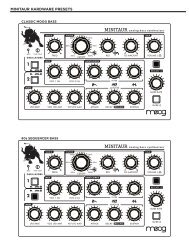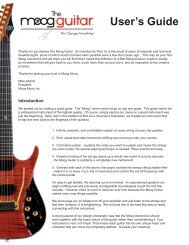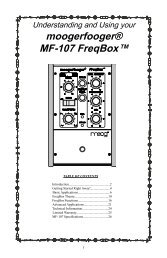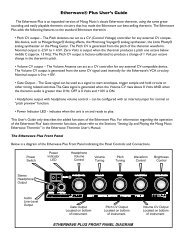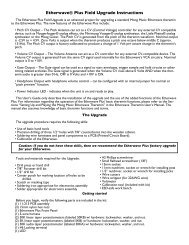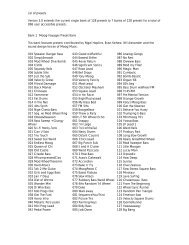Create successful ePaper yourself
Turn your PDF publications into a flip-book with our unique Google optimized e-Paper software.
<strong>MP</strong>-<strong>201</strong> User’s <strong>Manual</strong><br />
MIDI<br />
MIDI was developed as a standard way of communicating control signals digitally for<br />
musical devices or software across a MIDI or USB cable. Standard MIDI cables use 5-pin<br />
DIN connectors, and each cable can send MIDI data (MIDI OUT) or receive MIDI Data<br />
(MIDI IN). USB Cables combine both MIDI In and MIDI Out functions. MIDI data is<br />
sent as Messages. There are two categories of messages: Channel messages and System<br />
Messages.<br />
MIDI allows for up to 16 MIDI Channels on each MIDI Cable – thus Channel messages<br />
are assigned to one of sixteen MIDI Channels. The different channels can be used to<br />
address different devices, or different sounds or sound parameters within a single device.<br />
Types of Channel Messages include Note On/Note Off (not used in the <strong>MP</strong>-<strong>201</strong>),<br />
Program Change Messages (used to select presets in a device) or Continuous Controller<br />
(CC) Messages. CC Messages are like the CVs of MIDI – they are a control signal with<br />
128 levels. In many MIDI devices, CCs can be used in a manner akin to a CV, changing<br />
pitch or volume for example.<br />
A System Message is a general message and does not address a particular channel. A<br />
System Exclusive (SysEx) message is a type of System message that is defined only for<br />
a particular device, so that other devices will ignore it. That could be the settings of a<br />
particular preset, or the collected settings of a bank of presets, or it could be a larger file<br />
such as a firmware file that updates the operating system of the device. A MIDI CLOCK<br />
message is a type of System Message that is a REAL TIME message and provides tempo<br />
information to other MIDI devices. There are 24 MIDI Clock messages transmitted for<br />
every quarter note. The <strong>MP</strong>-<strong>201</strong> can be set to sync LFOs to various time divisions of a<br />
current tempo by MIDI clock messages.<br />
Please note that though MIDI is a standard communications protocol, it is old (published<br />
in 1983), serial (sends one message after the other), and slow (31.25 Kbaud). The <strong>MP</strong>-<br />
<strong>201</strong> can send out a lot of MIDI data at once, especially when a Preset Channel is set as<br />
an LFO. Some devices and software may not handle this data in a predictable way. It<br />
is up to the user to know and understand the MIDI implementation of a device before<br />
connecting it to the <strong>MP</strong>-<strong>201</strong>. Also be aware that MIDI loops (connecting MIDI In to<br />
MIDI Out on two devices) may occur when using the <strong>MP</strong>-<strong>201</strong> with sequencer software.<br />
This should be avoided, especially when using the MIDI USB connection, as MIDI loops<br />
can cause unpredictable behavior.<br />
Page 14



